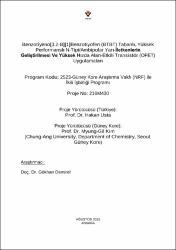| dc.contributor.author | Usta, Hakan | |
| dc.contributor.author | Demirel, Gökhan | |
| dc.date.accessioned | 2024-03-18T13:00:29Z | |
| dc.date.available | 2024-03-18T13:00:29Z | |
| dc.date.issued | 2019 | en_US |
| dc.identifier.uri | https://hdl.handle.net/20.500.12573/2017 | |
| dc.description.abstract | Bu projede, daha önce literatürde bulunmayan, özgün kimyasal yapılara sahip 6 farklı
düşük LUMO’lu BTBT-tabanlı yarı-iletken moleküler malzeme quantum mekaniksel
hesaplamalarla teorik olarak tasarlanmış ve sentezlenmiştir. Bu yeni yarı-iletkenlerin
saflaştırma sonrası detaylı bir şekilde yapısal, fizikokimyasal ve optoelektronik
karakterizasyonları yapılıp organik alan-etkili transistör uygulamaları çalışılmıştır. Bunun
sonucunda, dünyada ilk defa n-tipi olarak çalışabilen ve oldukça yüksek yarı-iletkenlik
performansı gösteren (μe = 0.6 cm2
/V·s; Ion/Ioff = 107
-108
) BTBT yarı-iletken molekülü,
D(PhFCO)-BTBT, perflorofenilkarbonil grupları ile geliştirilmiştir. Geliştirilen D(PhFCO)-BTBT
molekülü, son yılların en önemli π-sistemlerinden birisi olan BTBT yapısının elektron iletimi
yapabileceğini literatürde ilk defa göstermesinin yanında, sahip olduğu yüksek elektron
akışkanlığı ile literatürdeki sayılı n-tipi yarı-iletken moleküllerden birisi olarak kayda geçmiştir.
Alkildisiyanovinilen ile fonksiyonelleştirilmiş D(C7CC(CN)2)-BTBT ise literatürde geliştirilmiş ilk
solüsyondan proses edilebilir n-tipi BTBT (μe = 0.001 cm2
/V·s, Ion/Ioff = 104
) yarı-iletken
molekülü olmuştur. Karbonil ve disiyanovinilen fonksiyonelleştirmelerinin BTBT yapısındaki
LUMO ve molekül-içi düzlemsellik etkisinin daha önceki π-sistemlerinden oldukça farklı
olduğu bulgusuna ulaşılmıştır. Geliştirilen moleküler yarı-iletkenlerin moleküler
dizilim/morfolojik/mikro-nanoyapı özellikleri dikkatlice incelendiğinde fonksiyonel grupların ve
sübstitüyenlerin yarı-iletkenlik üzerindeki etkisi ortaya çıkarılmıştır. Ayrıca, bu projede
geliştirilen farklı π-sistemlere sahip yarı-iletken kütüphanesinin detaylı incelemesi sonucunda
“kimyasal yapı-optoelektronik özellikler-aygıt performansı” ilişkileri detaylı olarak çalışılmış,
elektron-iletim özelliği olan yeni BTBT malzemelerinin geliştirilmeye devam edilmesi için
ileriki çalışmalara ışık tutacak önemli bulgulara erişilmiştir. | en_US |
| dc.description.abstract | In this project, six novel BTBT-based semiconducting molecules with low LUMO
energetics have been designed by using quantum mechanical calculations and synthesized
via conventional synthetic chemistry. The structural, physicochemical, and optoelectronic
properties of these new semiconductors have been characterized in depth and they have
been studied in organic field-effect transistor (OFET) applications. The most important
outcome of this project is that the first n-type BTBT semiconducting molecule (D(PhFCO)-
BTBT) in the literature has been developed with a very high transistor performance (μe = 0.6
cm2
/V‧s, Ion/Ioff = 107
-108
). This molecule containing perfluorophenylcarbonyl end-groups
demonstrates for the first time that the BTBT scaffold, as one of the most important πsystems of the past decade, could effectively transport electrons in optoelectronic devices.
D(PhFCO)-BTBT is also one of the few n-type semiconducting molecules in the literature with
an electron mobility of μe ˃ 0.5 cm2
/V. Alkyldicyanovinylene functionalized D(C7CC(CN)2)-
BTBT has also been demonstrated as the first solution-processed molecular n-channel
BTBT (μe = 0.001 cm2
/V‧s, Ion/Ioff = 104
) semiconductor in the literature. Carbonyl and
dicyanovinylene functionalization on BTBT π-core has been found to have interesting effects
on the LUMO and intramolecular co-planarity, which is very different than the previously
developed π-systems. When the molecular packing/morphology/micro-nanostructure
properties of these new semiconductors have been investigated in detail, the effects of
functional groups and substitutions on their semiconducting characteristics are revealed. In
addition, as a result of the detailed investigation of the BTBT molecular library developed in
this project, “chemical structure-optoelectronic properties-device performance” relationships
have been elucidated, which could shed light on further studies for electron transporting
BTBT based semiconductors. | en_US |
| dc.language.iso | tur | en_US |
| dc.publisher | TUBİTAK | en_US |
| dc.rights | info:eu-repo/semantics/openAccess | en_US |
| dc.subject | organik yarı-iletken | en_US |
| dc.subject | organik optoelektronik | en_US |
| dc.subject | benzotiyeno[3,2- b][1]benzotiyofen (BTBT) | en_US |
| dc.subject | organik alan-etkili transistör (OFET) | en_US |
| dc.subject | π-konjüge küçük molekül | en_US |
| dc.subject | organic semiconductor | en_US |
| dc.subject | organic optoelectronics | en_US |
| dc.subject | benzothieno[3,2- b][1]benzothiophene (BTBT) | en_US |
| dc.subject | organic field-effect transistor (OFET) | en_US |
| dc.subject | π-conjugated small molecule | en_US |
| dc.title | Benzotiyeno[3,2-B][1]Benzotiyofen (BTBT) Tabanlı, Yüksek Performanslı N-Tipi/Ambipolar Yarı-İletkenlerin Geliştirilmesi Ve Yüksek Hızda Alan-Etkili Transistör (OFET) Uygulamaları | en_US |
| dc.type | project | en_US |
| dc.contributor.department | AGÜ, Mühendislik Fakültesi, Malzeme Bilimi ve Nanoteknoloji Mühendisliği Bölümü | en_US |
| dc.contributor.authorID | 0000-0002-0618-1979 | en_US |
| dc.contributor.institutionauthor | Usta, Hakan | |
| dc.identifier.startpage | 1 | en_US |
| dc.identifier.endpage | 81 | en_US |
| dc.relation.journal | Tubitak | en_US |
| dc.relation.tubitak | 216M430 | |
| dc.relation.publicationcategory | Diğer | en_US |


















